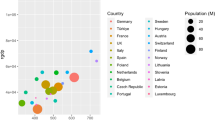Abstract
This study measures the efficiencies incorporating waste generation using Japanese prefecture level data. We apply and compare several models using directional distance functions. There are wide variations in the efficiency scores between the two orientations, “input, desirable and undesirable output orientation” and “undesirable output orientation”. However, the difference in abatement factor does not result in wide variations in the efficiency scores. Our results show that there are wide differences in the efficiency scores among prefectures.




Similar content being viewed by others
Notes
There are two factors that have the impact on the relationship between the efficiency scores based on Kuosmanen technology and those based on Färe and Grosskopf technology. (1) The efficiency scores of model A may be equal to or larger than those of model C because the frontier of Kuosmanen technology is larger than that of Färe and Grosskopf technology. (2) In Kuosmanen technology, in calculating efficiency scores of a specific prefecture k′, DEA decides z k and θk in order to make prefecture k′ more efficient compared to the case where z k and θk take the other values. On the other hand, in Färe and Grosskopf technology, θ is common to all the prefectures. Therefore, Färe and Grosskopf technology is more restrictive than Kuosmanen technology. Due to the restriction, the efficiency scores of prefecture k′ calculated under Färe and Grosskopf technology may not take smaller value than those calculated under Kuosmanen technology. Therefore, efficiency scores may be smaller in model A than those in model C. Since there are two effects, the relationship of the scores of models A and C cannot be decided in advance. In this study, Aichi, Ishikawa, Kyoto, Osaka, Hyogo and Hiroshima prefecture have smaller efficiency scores when they calculated under Kuosmanen technology than under Färe and Grosskopf technology.
References
Banker RD, Charnes A, Cooper WW (1984) Some models for estimating technical and scale inefficiencies in Data Envelopment Analysis. Manag Sci 30:1078–1092
Charnes A, Cooper WW, Rhodes E (1978) Measuring the efficiency of decision making units. Eur J Oper Res 2:429–444
Färe R, Grosskopf S (2003) Nonparametric productivity analysis with undesirable outputs: comment. Am J Agr Econ 85:1070–1074
Färe R, Grosskopf S (2009) A comment on weak disposability in nonparametric production analysis. Am J Agr Econ 91:535–538
Färe R, Grosskopf S, Lovell CAK, Pasurka C (1989) Multilateral productivity comparisons when some outputs are undesirable: a nonparametric approach. Rev Econ Stat 71:90–98
Färe R, Grosskopf S, Tyteca D (1996) An activity analysis model of the environmental performance of firms—application to fossil-fuel-fired electric utilities. Ecol Econ 18:161–175
Fukuyama H, Yoshida Y, Managi S (2011) Modal choice between air and rail: a social efficiency benchmarking analysis that considers CO2 emissions. Environ Econ Policy Stud 13:89–102
Huppes G, Ishikawa M (2007) Quantified eco-efficiency an introduction with applications. Springer, Dordrecht
Kainou K (2006) The analysis of the estimation results of the prefectural energy consumption statistics I. Research Institute of Economy, Trade and Industry, Tokyo
Kainou K (2007) The explanation of the prefectural energy consumption statistics. Research Institute of Economy, Trade and Industry, Tokyo
Kumar S, Managi S (2010) Environment and productivities in developed and developing countries: the case of carbon dioxide and sulfur dioxide. J Environ Manag 91(7):1580–1592
Kuosmanen T (2005) Weak disposability in nonparametric production analysis with undesirable outputs. Am J Agr Econ 87:1077–1082
Kuosmanen T, Podinovski V (2009) Weak disposability in nonparametric production analysis: reply to Färe and Grosskopf. Am J Agr Econ 91:539–545
Managi S (2003) Luenberger and Malmquist productivity indices in Japan, 1955–1995. Appl Econ Lett 10:581–584
Managi S, Kaneko S (2010) Chinese economic development and environment. Edward Elgar Publishing Ltd, Cheltenham
Managi S, Opaluch JJ, Jin D, Grigalunas TA (2004) Technological change and depletion in offshore oil and gas. J Environ Econ Manag 47(2):388–409
Nakano M, Managi S (2010) Productivity analysis with CO2 emissions in Japan. Pac Econ Rev 15:708–718
Nemoto J, Goto M (2005) Productivity, efficiency, scale economies and technical change: a new decomposition analysis of TFP applied to the Japanese prefectures. J Jpn Int Econ 19:617–634
Picazo-Tadeo AJ, Reig-Martínez E, Hernández-Sancho F (2005) Directional distance functions and environmental regulation. Resour Energy Econ 27:131–142
Powell JC, Turner RK, Bateman IJ (eds) (2001) Managing the environment for sustainable development: waste management and planning. Edward Elgar, Cheltenham
Shephard RW (1970) Theory of cost and production function. Princeton University Press, Princeton
Shinkuma T, Managi S (2011) License scheme: an optimal waste management policy under asymmetric information. J Regul Econ 39(2):143–168
Shinkuma T, Managi S (2012) Effectiveness of policy against illegal disposal of waste. Environ Econ Policy Stud 14(2):123–145
Taskin F, Zaim O (2001) The role of international trade on environmental efficiency: a DEA approach. Econ Model 18:1–17
Tyteca D (1997) Linear programming models for measurement of environmental performance of firms—concepts and empirical results. J Prod Anal 8:83–97
Yaisawarng S, Klein JD (1994) The effects of sulfur dioxide controls on productivity change in the US electric power industry. Rev Econ Stat 76:447–460
Yamano N, Ohkawara T (2000) The regional allocation of public investment: efficiency or equity? J Reg Sci 40:205–229
Author information
Authors and Affiliations
Corresponding author
About this article
Cite this article
Nakano, M., Managi, S. Waste generations and efficiency measures in Japan. Environ Econ Policy Stud 14, 327–339 (2012). https://doi.org/10.1007/s10018-012-0038-2
Received:
Accepted:
Published:
Issue Date:
DOI: https://doi.org/10.1007/s10018-012-0038-2




